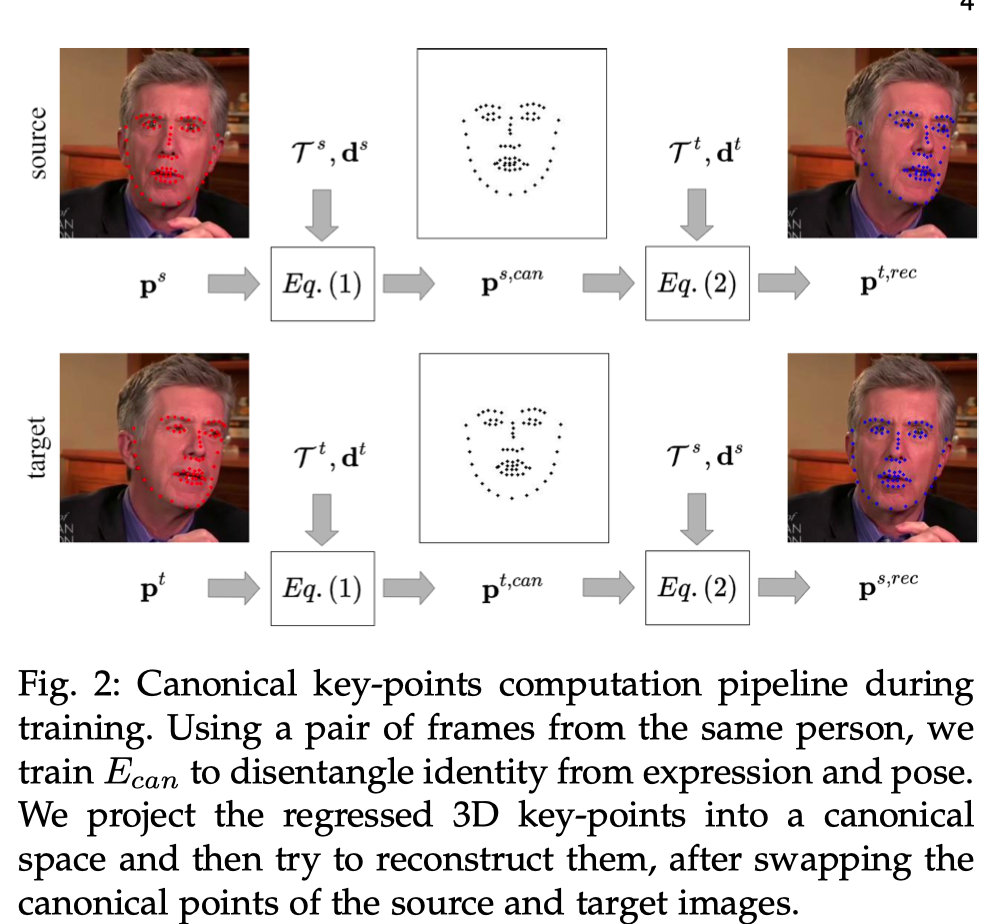Free-HeadGAN: Neural Talking Head Synthesis with Explicit Gaze Control 链接到标题
* Authors: [[Michail Christos Doukas]], [[Evangelos Ververas]], [[Viktoriia Sharmanska]], [[Stefanos Zafeiriou]]
初读印象 链接到标题
Free-HeadGAN
TL;DR 链接到标题
- canonical 3D key-point estimator + gaze estimation network + generator
- use a neural network that learns to predict dense optical flow
- does not predict canonical key-points directly
contributes 链接到标题
- We release HeadGAN from its 3DMM priors, using sparse 3D landmarks
- a module that performs disentanglement of identity, expression and pose through the computation of canonical 3D key-points.
- propose a network that regresses 3D meshes of the eyes. We use these meshes to obtain the direction of gaze, which is then used to condition image synthesis
methodology 链接到标题
- Each component of FreeHeadGAN is trained separately on its individual task
canonical keypoints 链接到标题

- Given a portrait image, our goal here is to extract a set of key-points in a canonical space, which are independent both from the head pose and facial expressions of the subject.
- regress sparse 3D facial key-points
- estimate head pose
- models the nonlinearity of deformations caused by facial expressions
obtain canonical keypoints: $$ \mathbf{p}_k^{c a n}=\frac{1}{s} \mathbf{R}^{-1}\left(\mathbf{p}_k-\mathbf{d}_k-\mathbf{t}\right), \quad k=1, \ldots, K $$
inverse:
$$ \mathbf{p}_k=s \mathbf{R} \mathbf{p}_k^{c a n}+\mathbf{t}+\mathbf{d}_k, \quad k=1, \ldots, K $$
3d keypoints loss
loss between predict and target $$ \mathcal{L}^p=\left|\mathbf{p}^s-\mathbf{1}^s\right|_2^2+\left|\mathbf{p}^t-\mathbf{1}^t\right|_2^2 $$
loss between reconstruction and target $$ \mathcal{L}^{r e c}=\left|\mathbf{p}^{s, r e c}-\mathbf{1}^s\right|_2^2+\left|\mathbf{p}^{t, r e c}-\mathbf{1}^t\right|_2^2 $$
penalise the error between the predicted target head rotation a regularisation term on the expression deformation vectors ensures that key-point perturbations due to expressions are kept small, as we want to avoid encoding identity-specific details in these vectors $$ \mathcal{L}^R=\left|\mathbf{R}^t-\mathbf{R}_*^t\right|_2^2, \quad \mathcal{L}^d=\left|\mathbf{d}^s\right|_2^2+\left|\mathbf{d}^t\right|_2^2 $$
$$ \mathcal{L}{E{c a n}}=\lambda_p \mathcal{L}^p+\lambda_{\text {rec }} \mathcal{L}^{r e c}+\lambda_R \mathcal{L}^R+\lambda_d, \mathcal{L}^d $$
gaze estimation 链接到标题
- predict 3D meshes of eyes instead of 3D gaze vectors or angles estimating dense geometry instead of few pose parameters, has recently been shown to benefit face and body pose estimation systems
- based on 2D sparse landmarks around the iris contour and the available gaze labels.
losses
predicted coordinates v and the corresponding pseudo-ground truth ones v* : $$ \mathcal{L}^v=\left|\mathbf{v}-\mathbf{v}^*\right|_1 $$
between the 3N t eye edge lengths e computed from v and those, e ∗ , computed from v ∗ $$ \mathcal{L}^e=\left|\mathbf{e}-\mathbf{e}^\right|_1 $$ gaze loss $$ \mathcal{L}^g=(180 / \pi) \arccos \left(\mathbf{g}^T \mathbf{g}^\right) $$
$$ \mathcal{L}{E{\text {gaze }}}=\lambda_v \mathcal{L}^v+\lambda_e \mathcal{L}^e+\lambda_g \mathcal{L}^g $$
$$ \theta=\arctan \sqrt{g_x^2+g_y^2} / g_z, \quad \phi=\arctan g_y / g_z $$
Images synthesis 链接到标题

- based on the generator of HeadGAN
- draw a source and a target image sketch. Gaze angles are color coded in the sketches, within the areas defined by keypoints that belong to the eyes.
- network G is comprised of two modules: a flow network and a rendering network
- the flow network extracts visual feature maps from the source image and its corresponding key-point sketch in multiple spatial resolutions
- target sketch is injected into the network, guides the prediction of the optical flow w
- we utilise the backward optical flow warping operator from FlowNet ~`2.0
- The rendering network passes the target sketch through an encoder and combines the extracted feature map with (i) the warped features and warped image $\overline{\mathbf{x}}=\mathbf{w}\left(\mathbf{x}^s\right)$
N-shot extension 链接到标题
- addition of one more output layer to the flow network, which now learns to compute a set of 2D weights $m \in{\mathbb{R}^{H×W}}$
$$ \overline{\mathbf{x}}=\frac{\sum_j^M \exp \left(\mathbf{m}_j\right) \mathbf{w}_j\left(\mathbf{x}_j^S\right)}{\sum_j^M \exp \left(\mathbf{m}_j\right)} $$
warped features:
$$ \overline{\mathbf{h}}^{(i)}=\frac{\sum_j^M \exp \left(\mathbf{m}_j\right) \mathbf{w}_j\left(\mathbf{h}_j^{(i)}\right)}{\sum_j^M \exp \left(\mathbf{m}_j\right)}, \quad i=1, \ldots, L $$
optical flow and rendering networks that make G are trained jointly
minimising the distance between feature maps extracted from multiple layers of a pre-trained VGG network $$ \mathcal{L}_G^{V G G}=\sum\left|V G G_l(\tilde{\mathbf{x}})-V G G_l\left(\mathbf{x}^t\right)\right|_1 $$
we apply a VGG loss on the warped image, in order to force the flow network to learn a correct flow from the source image to the desired head pose, which gives the loss term $\mathcal{L}_F^{VGG}$
improve the photo-realism of synthetic images by placing an adversarial loss term $\mathcal{L}^{adv}_G$
specifically a Hinge GAN loss
we employ two critics, a general image discriminator $D_I$ and a dedicated discriminator $D_M$ for the mouth area
$$ \mathcal{L}_G=\mathcal{L}G^{a d v}+\lambda{V G G}\left(\mathcal{L}_G^{V G G}+\mathcal{L}F^{V G G}\right)+\lambda{F M} \mathcal{L}_G^{F M} $$
Inference 链接到标题
- we use $E_{canto}$ regress 3D key-points, head pose and expression deformations from $x_s$ obtain the canonical key-points $\mathbf{p}^{s, c a n}$
- estimate the target pose and expression $\mathcal{T}^t, \mathbf{d}^t$ from $\mathbf{x}^t$, The adapted target key-points $\mathbf{p}^{s, a d a p t}$ are obtained with the application of Eq. 2
- estimate eye gaze from both images with E gaze network and finally draw the sketches that serve as input to generator G